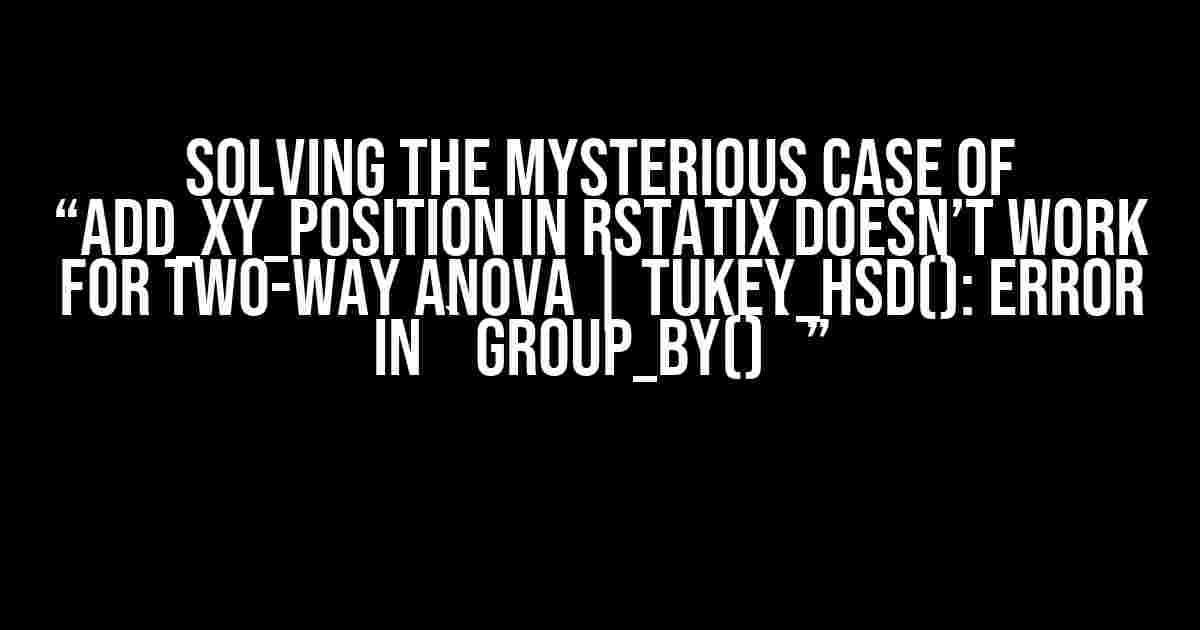Are you tired of encountering the frustrating error “add_xy_position in rstatix doesn’t work for two-way ANOVA | tukey_hsd(): Error in `group_by()`” while trying to visualize your two-way ANOVA results in R? You’re not alone! In this article, we’ll dive into the root cause of this issue and provide a step-by-step guide to overcome it, ensuring you can elegantly display your Tukey’s HSD test results.
What’s the Problem?
The `rstatix` package in R provides an efficient way to perform various statistical tests, including two-way ANOVA. However, when attempting to add xy-positioning labels to the plot using `add_xy_position()`, you might encounter the following error:
Error in `group_by()`:
! Must group by variables found in `.data`.
Column `groups` is not found.
Run `rlang::last_error()` to see where the error occurred.
This error occurs because the `group_by()` function in `dplyr` (which is used internally by `rstatix`) is unable to find the `groups` column in the data.
Understanding the `tukey_hsd()` Function
The `tukey_hsd()` function in `rstatix` is used to perform Tukey’s Honestly Significant Difference (HSD) test, a post-hoc analysis technique for comparing means between groups. The function takes a formula as input, specifying the response variable and the grouping factors.
For example, consider a two-way ANOVA model with `response` as the response variable and `factorA` and `factorB` as the grouping factors:
library(rstatix)
anova_result <- anova_test(response ~ factorA * factorB, data = my_data)
tukey_hsd(anova_result, conf.level = 0.95)
This would perform the Tukey’s HSD test for the interaction between `factorA` and `factorB`.
The `add_xy_position()` Function
The `add_xy_position()` function is used to add xy-positioning labels to a plot, allowing you to easily identify the groups being compared. However, in the context of two-way ANOVA, `add_xy_position()` requires a bit more tweaking to work correctly.
Solution: A Step-by-Step Guide
To overcome the error and successfully add xy-positioning labels to your plot, follow these steps:
-
Load the necessary libraries:
library(rstatix) library(ggplot2) library(dplyr) -
Perform the two-way ANOVA using `anova_test()`:
anova_result <- anova_test(response ~ factorA * factorB, data = my_data) -
Extract the Tukey’s HSD test results using `tukey_hsd()`:
tukey_result <- tukey_hsd(anova_result, conf.level = 0.95) -
Convert the `tukey_result` object to a dataframe:
tukey_df <- as.data.frame(tukey_result) -
Merge the original data with the Tukey’s HSD test results:
merged_data <- left_join(my_data, tukey_df, by = c("factorA", "factorB")) -
Use `ggplot2` to create a plot with the merged data:
library(ggplot2) p <- ggplot(merged_data, aes(x = factorA, y = response, color = factorB)) + geom_point() + geom_line(aes(group = interaction(factorA, factorB))) + theme_classic() -
Finally, add xy-positioning labels using `add_xy_position()`:
p + add_xy_position("groups")
Voilà! You should now have a beautiful plot with xy-positioning labels, correctly displaying the Tukey’s HSD test results for your two-way ANOVA model.
Troubleshooting Tips
If you still encounter issues, ensure that:
-
your data is properly structured, with the response variable and grouping factors correctly specified;
-
you’ve loaded the necessary libraries (rstatix, ggplot2, and dplyr);
-
you’ve correctly merged the original data with the Tukey’s HSD test results;
-
you’ve specified the correct aesthetics in the `ggplot()` function.
Conclusion
In this article, we’ve delved into the mysterious case of “add_xy_position in rstatix doesn’t work for two-way ANOVA | tukey_hsd(): Error in `group_by()`.” By following the step-by-step guide, you should now be able to elegantly visualize your Tukey’s HSD test results for two-way ANOVA models in R. Remember to double-check your data structure, library loading, and plot aesthetics to ensure a smooth experience.
| Package | Function | Description |
|---|---|---|
| rstatix | anova_test() | Performs two-way ANOVA |
| rstatix | tukey_hsd() | Performs Tukey’s HSD test |
| ggplot2 | ggplot() | Creates a plot |
| rstatix | add_xy_position() | Adds xy-positioning labels to a plot |
Happy plotting!
Frequently Asked Question
Get answers to your burning questions about “add_xy_position in rstatix doesn’t work for two-way ANOVA | tukey_hsd() | Error in `group_by():”
What is the error message I get when using add_xy_position with two-way ANOVA in rstatix?
You get an error message “Error in `group_by()`: Column `x` is unknown” when using add_xy_position with two-way ANOVA in rstatix.
Why does add_xy_position not work with two-way ANOVA in rstatix?
add_xy_position doesn’t work with two-way ANOVA in rstatix because the function is not designed to handle interactions between multiple variables. It’s intended for simple one-way ANOVA.
Can I use add_xy_position with tukey_hsd() in rstatix for two-way ANOVA?
No, you can’t use add_xy_position with tukey_hsd() in rstatix for two-way ANOVA. You’ll get the “Error in `group_by()`: Column `x` is unknown” error. Instead, you can use other visualization methods or packages that support two-way ANOVA.
How do I visualize the results of two-way ANOVA in rstatix?
You can use other visualization methods in rstatix, such as ggplot2 or plotly, to visualize the results of two-way ANOVA. You can also use other R packages that support two-way ANOVA, like afex or emmeans.
Is there an alternative to add_xy_position in rstatix for two-way ANOVA?
Yes, you can use other visualization methods or packages that support two-way ANOVA. For example, you can use the “interaction.plot()” function in base R or the “afex_plot()” function in the afex package.


